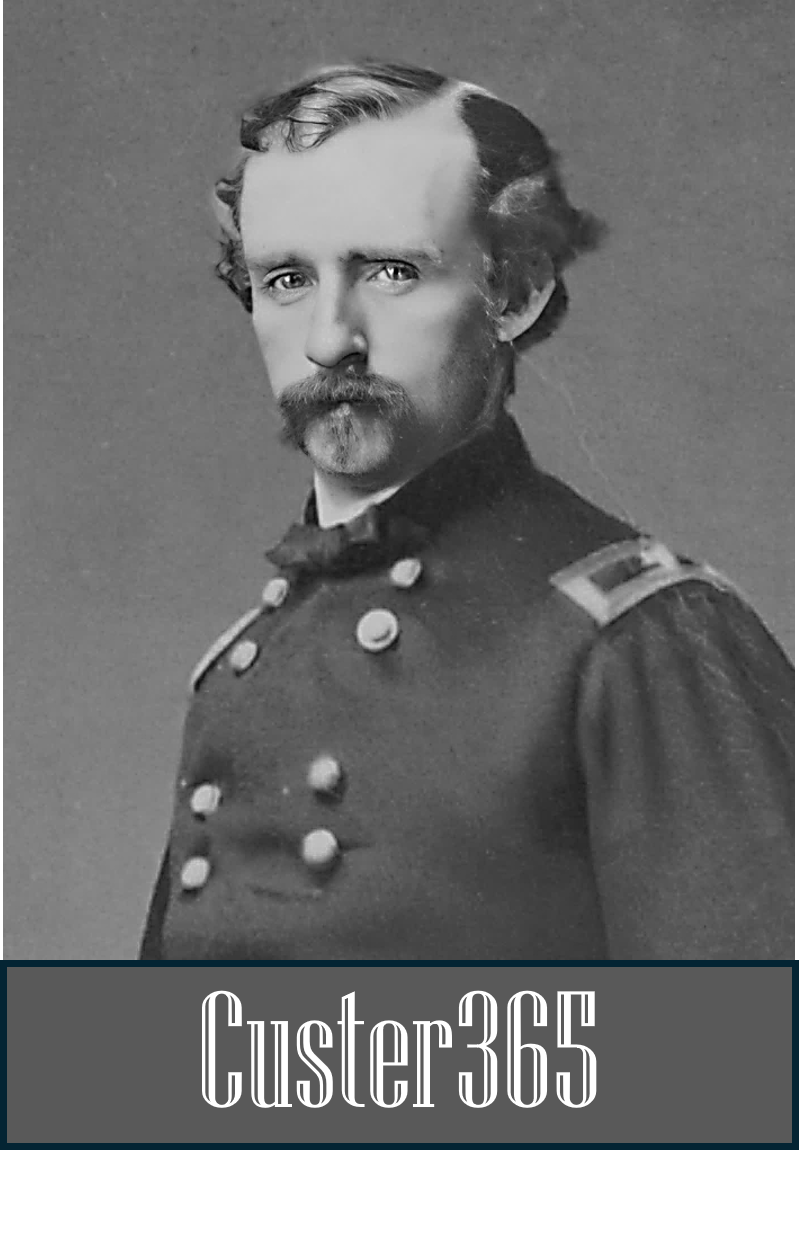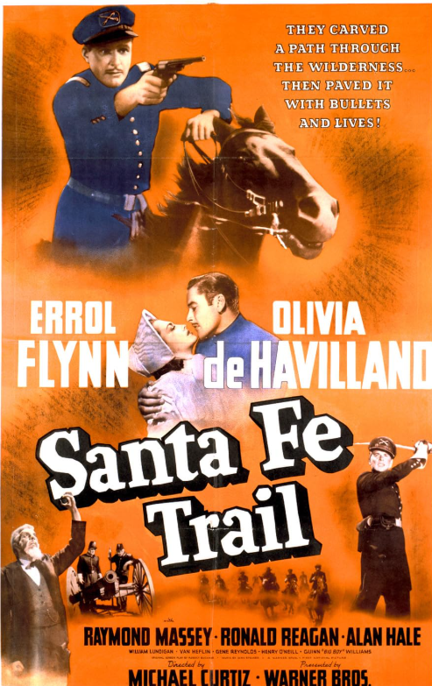AUG 3: Custer Movies: Take One
Multiple motion pictures and TV series have been produced over the years that either feature George Armstrong Custer as the main character or as a sidekick. Some have stood the test of time, while others should remain out of sight.
One that may have had cinematic merit but failed completely at factual accuracy is “Santa Fe Trail”, which Warner Bros. released in 1940. It starred Ronald Reagan as Custer, Errol Flynn as J.E.B. Stuart, and Raymond Massey as eye-popping, sword-wielding abolitionist John Brown. It was directed by Michael Curtiz, a noted Hollywood director who won an Academy Award for directing the classic Casablanca in 1942.
The story opens at West Point in 1854, where cadet Rader (Van Heflin) loudly voices approval of abolitionist John Brown and his fight against slavery. Classmate J.E.B. Stuart (Flynn), a Virginian, takes offense and fisticuffs ensue. The Superintendent of the Point, Robert E. Lee, dismisses Rader from the academy and assigns Stuart and six of his graduating classmates (including George Custer) to a cavalry post at Fort Leavenworth in Kansas Territory.
Fort Leavenworth was smack in the middle of a bloody war between abolitionists and pro-slavers. A vote was coming up for statehood and John Brown and his ilk wanted Kansas to enter the Union as a free state. The opposition wanted Kansas to join the Southern states as a slave holding state. Needless to say, they didn’t merely debate the issue. They tried slaughtering one another. The “Bloody Kansas” era ran from 1854 to 1861.
“They carved a path through the wilderness, then paved it with bullets and lives.”
The cavalry’s job in the film was to keep the peace and capture lunatic abolitionist agitator John Brown. As Stuart and Custer accompany wagons carrying bibles into Kansas (the cases actually stored rifles), “slavers” and John Brown’s kin exchange gunfire. Later, Stuart is captured at a barber shop by his West Point sparring partner and Brown supporter, cadet Rader. Before he can be hanged, Stuart escapes to a nearby barn. Who rushes to the scene to save his old buddy? Why it’s Ronny Reagan/George Custer. He rescues his “friend” and they drive off John Brown’s men.
To celebrate their victory over Brown, Stuart and Custer attend a fancy ball back in Washington, D.C. (huh??), where they get a tip that John Brown plans to seize the federal government’s arsenal of weapons at Harper’s Ferry on the Maryland-Virginia border. Brown intends to arm slaves and begin a slave revolt. Stuart and Custer arrive just in time to capture Brown.
How many times can I call “b&%2hit” without offending anyone?
For starters, in 1854 Custer was 15 years old and was likely attending school in Ohio.
James Ewell Brown Stuart was known to friends as Jeb. The film has Stuart and Custer graduating together in the class of 1854, but it was Stuart that graduated that year (13th in his class of 34 cadets.) Custer was in the class of 1862, but the entire class was allowed to graduate one year early in order to join the Union effort in the Civil War. (BTW: Custer graduated dead last in his class.)
The film claims Stuart and Custer became lifelong friends. Wrong. The closest they may ever have gotten to one another was on a battlefield at Gettysburg on July 3. Stuart’s cavalry, which had been mysteriously absent from July 1-2, squared off with Custer and his Michigan Volunteers on East Cavalry Field on the final day. But, they were never friends.
One thing the screenwriter, Robert Buckner, got right was Robert E. Lee did serve as Superintendent of West Point from 1852-55.
Stuart served in Texas after graduating from West Point. He was assigned to the Regiment of Mounted Rifles and participated in campaigns against the Apaches. He was eventually transferred to Fort Leavenworth. So, he was at the fort at some point in time.
Custer was stationed at Fort Leavenworth, Kansas, but that came after the Civil War. He was court-martialed there in 1867. He was found guilty of being absent without leave and other charges related to his conduct during a campaign against Native Americans in the summer of 1867.
Jeb Stuart was at Harper’s Ferry during John Brown’s raid, Oct. 16-18, 1859. Custer was not. He was in his third year at West Point. Stuart served as an aide-de-camp to Colonel Robert E. Lee during the US Army's response to Brown’s siege and delivered Lee's terms of surrender to the abolitionist. Stuart later signaled the marines to attack the engine house where Brown and his followers were holed up. Brown was captured, then tried and convicted of treason against the Commonwealth of Virginia, the murder of five men, and inciting a slave insurrection. He was executed on December 2, 1859.
Probably the biggest head scratcher is what did any of these people have to do with the Santa Fe Trail. It was a western movie, after all.
The trail started in Franklin, Missouri, ran through Kansas (nowhere near Fort Leavenworth) into southeast Colorado, then terminated in northern New Mexico.
Stuart, Custer and John Brown spent time in Kansas, but there’s no evidence to suggest any of them ever "rode" the Santa Fe Trail. That’s Hollywood for you.


